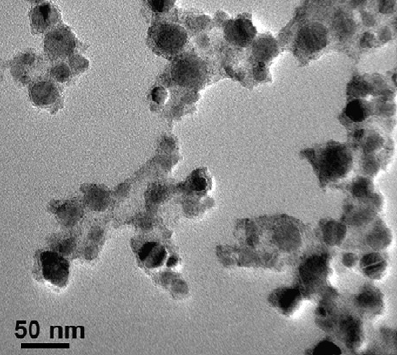

Executive Summary
Harmful microbes are present in various sources including water, food, plants, and through human-to-human transmission. The ability to detect them rapidly at a low cost is important to protecting the health and safety of humans and animals and the security of food chains. MSU researchers have developed novel nanoparticle-based biosensors for rapidly sensing pathogens in complex matrices or media. The biosensors can be used in a variety of application settings without the need for pre-purification, lengthy culturing, and amplification. Devices for determining pathogen content as a function of electrical input are also provided.
Description of Technology
This technology covers a suite of inventions relating to biologically enhanced electrically active magnetic nanoparticles (a.k.a. BEAM). The particles are based on magnetic Fe2O3 nanoparticles encapsulated with a conductive polymer such as polyaniline (PANI). The nanoparticles can be coated with a capture reagent that may include antibodies, carbohydrates, antigens, hormones, oligonucleotides, or polynucleotides. Upon mixing with the media containing the bacteria, the coated BEAMs bind to the microbes which can be selectively separated with a magnet to concentrate them. The concentrated nanoparticle-microbes can then be applied to an electrode-based test kit (including screen-printed carbon electrodes) where conductance or resistance can be measured. The nanoparticle-microbe concentrate can also be reacted with a label such as an enzyme, chromogenic substrate, chromophore, chemiluminescent molecules, etc. for alternative measurement approaches. Patents include systems and methods of detection of analytes.
Benefits
- Simple method of detecting bacteria, viruses, and other pathogens present in a sample
- Can detect multiple pathogens or specific pathogen
- Can be used on multiple media such as sputum, water, food matrixes, urine, blood
- Eliminates pre-enrichment, purification, pre-treatment steps
- Rapid detection within 1-2 hours
- Inexpensive test method
Applications
- Disease and health monitoring
- Food pathogen detection and monitoring of food quality
- Environmental water monitoring
- Agricultural disease detection (crops, plants, farm animal products and health)
Patent Status
Issued US patents US 8,859,297, US 8,936,946, US 10,739,337
Licensing Rights
Full licensing rights available
References
Biosystems Engineering 2008 paper
Biosensors and Bioelectronics 2009 paper
Biosensors and Bioelectronics 2011 paper
Biosensors 2012 paper
Inventors
Dr. Evangelyn Alocilja, Dr. Sudeshna Pal, Emma Setterington, Dr. Barbara Cloutier, Dr. Michael Anderson
TECH ID
TEC2007-0157, TEC2010-0030, TEC2012-0006